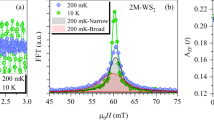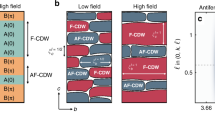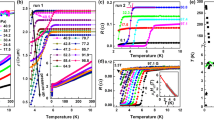Abstract
Charge density waves (CDWs) are periodic modulations of the density of conduction electrons in solids. They are collective states that arise from intrinsic instabilities often present in low-dimensional electronic systems. The most well-studied examples are the layered dichalcogenides–an example of which is TiSe2, one of the first CDW-bearing materials to be discovered. At low temperatures, a widely held belief is that the CDW competes with another collective electronic state, superconductivity. But despite much exploration, a detailed study of this competition is lacking. Here we report how, on controlled intercalation of TiSe2 with Cu to yield CuxTiSe2, the CDW transition can be continuously suppressed, and a new superconducting state emerges near x=0.04, with a maximum transition temperature Tc of 4.15 K at x=0.08. CuxTiSe2 thus provides the first opportunity to study the CDW to superconductivity transition in detail through an easily controllable chemical parameter, and will provide fundamental insight into the behaviour of correlated electron systems.
This is a preview of subscription content, access via your institution
Access options
Subscribe to this journal
Receive 12 print issues and online access
$209.00 per year
only $17.42 per issue
Buy this article
- Purchase on Springer Link
- Instant access to full article PDF
Prices may be subject to local taxes which are calculated during checkout






Similar content being viewed by others
References
Wilson, J. A. & Yoffe, A. D. The transition metal dichalcogenides discussion and interpretation of the observed optical, electrical and structural properties. Adv. Phys. 28, 193–335 (1969).
Wilson, J. A., Di Salvo, F. J. & Mahajan, S. Charge-density waves and superlattices in the metallic layered transition metal diehaleogenides. Adv. Phys. 24, 117–201 (1975).
Di Salvo, F. J., Moncton, D. E. & Waszczak, J. V. Electronic properties and superlattice formation in the semimetal TiSe2 . Phys. Rev. B 14, 4321–4328 (1976).
Kim, S. J. et al. AFM image visualization of layered dichalcogenides, 1T-MTe(2) (M=V, Ta). J. Phys. Chem. Solids 58, 659–663 (1997).
Kasuya, T., Jung, M. H. & Takabatake, T. Charge density wave and excitonic magnetic polarons in CeTe2 . J. Magn. Magn. Mater. 220, 235–258 (2000).
Boswell, F. W. & Bennett, J. C. Density waves in Nb3Te4: Effects of indium and thallium intercalation. Mater. Res. Bull. 31, 1083–1092 (1996).
Wang, C., Slough, C. G. & Coleman, R. V. Spectroscopy of dichalcogenides and trichalcogenides using scanning tunneling microscopy. J. Vac. Sci. Technol. B 9, 1048–1051 (1991).
Nagata, S. et al. Superconductivity in the layered compound 2H-TaS2 . J. Phys. Chem. Solids 53, 1259–1263 (1992).
Kumakura, T., Tan, H., Handa, T., Morishita, M. & Fukuyama, H. Charge density wave and superconductivity in 2H-TaSe2 . Czech. J. Phys. 46, 2611–2612 (1996).
Nunezregueiro, M., Mignot, J. M., Jaime, M., Castello, D. & Monceau, P. Superconductivity under pressure in linear chalcogenides. Synth. Met. 56, 2653–2659 (1993).
Mihaila, B. et al. Pinning Frequencies of the collective modes in α-uranium. Phys. Rev. Lett. 96, 76401 (2006).
Jaiswal, D. et al. Superconducting parameters of a CDW compound Lu5Ir4Si10 . Physica B 312, 142–144 (2002).
Singh, Y., Nirmala, R., Ramakrishnan, S. & Malik, S. K. Competition between superconductivity and charge-density-wave ordering in the Lu5Ir4(Si1-xGex)10 alloy system. Phys. Rev. B 72, 45106 (2005).
Morris, R. C. Connection between charge-density waves and superconductivity in NbSe2 . Phys. Rev. Lett. 34, 1164–1166 (1975).
Fang, L. et al. Fabrication and superconductivity of NaxTaS2 crystals. Phys. Rev. B 72, 14534 (2005).
Bachrach, R. Z. & Skibowski, M. Angle-resolved photoemission from TiSe2 using synchrotron radiation. Phys. Rev. Lett. 37, 40–42 (1976).
Woo, K. C. et al. Superlattice formation in titanium diselenide. Phys. Rev. B 14, 3242–3247 (1976).
Wilson, J. A. Concerning the semimetallic characters of TiS2 and TiSe2 . Solid State Commun. 22, 551–553 (1977).
Zunger, A. & Freeman, A. J. Band structure and lattice instability of TiSe2 . Phys. Rev. B 17, 1839–1842 (1978).
Myron, H. W. & Freeman, A. J. Electronic structure and optical properties of layered dichalcogenides: TiS2 and TiSe2 . Phys. Rev. B 9, 481–486 (1974).
Isomaki, H., Boehm, J. von & Krusius, P. Band structure of group IVA transition-metal dichalcogenides. J. Phys. C 12, 3239–3252 (1979).
Stoffel, N. G., Kevan, S. D. & Smith, N. V. Experimental band structure of 1T-TiSe2 in the normal and charge-density-wave phases. Phys. Rev. B 31, 8049–8055 (1985).
Kidd, T. E., Miller, T., Chou, M. Y. & Chiang, T.-C. Electron-hole coupling and the charge density wave transition in TiSe2 . Phys. Rev. Lett. 88, 226402 (2002).
Oftedal, I. Roentgenographische Untersuchungen von SnS2, TiS22, TiSe2, TiTe2 . Z. Phys. Chem. 134, 301–310 (1928).
Bussmann-Holder, A. & Buttner, H. Charge-density-wave formation in TiSe2 driven by an incipient antiferroelectric instability. J. Phys. Condens. Matter 14, 7973–7979 (2002).
Batlogg, B et al. Superconductivity in Bi-O and Sb-O perovskites. Physica C 162–164, 1393–1396 (1989).
Bardeen, J., Cooper, L. N. & Schrieffer, J. R. Theory of superconductivity. Phys. Rev. 108, 1175–1204 (1957).
Hake, R. R. Upper-critical-field limits for bulk type-II superconductors. Appl. Phys. Lett. 10, 189–192 (1967).
Carlin, R. L. Magnetochemistry (Springer, New York, 1986).
Acknowledgements
This research was supported primarily by the US DOE-BES solid state chemistry program, and, in part, by the US NSF MRSEC program.
Author information
Authors and Affiliations
Corresponding authors
Ethics declarations
Competing interests
The authors declare no competing financial interests.
Rights and permissions
About this article
Cite this article
Morosan, E., Zandbergen, H., Dennis, B. et al. Superconductivity in CuxTiSe2. Nature Phys 2, 544–550 (2006). https://doi.org/10.1038/nphys360
Received:
Accepted:
Published:
Issue Date:
DOI: https://doi.org/10.1038/nphys360
This article is cited by
-
Two-dimensional meta-magnetism in van der Waals layered material Cu2xFe1−xPS3
Science China Materials (2024)
-
Superconductivity induced by gate-driven hydrogen intercalation in the charge-density-wave compound 1T-TiSe2
Communications Physics (2023)
-
Precursor region with full phonon softening above the charge-density-wave phase transition in 2H-TaSe2
Nature Communications (2023)
-
Drastic Suppression of CDW (Charge Density Wave) by Pd Addition in TiSe2
Journal of Superconductivity and Novel Magnetism (2023)
-
Persistence of charge density wave against variation of band structures in VxTi1−xSe2(x = 0−0.1)
Nano Research (2023)



